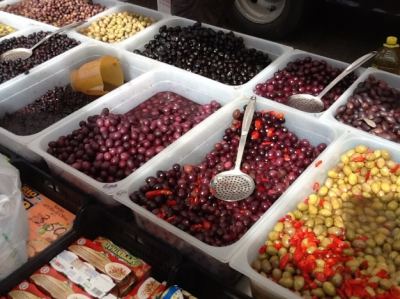Producing table olives
Food facts. We eat so many olives, mostly as appetizers, or in cocktails, yet we never ask ourselves how they are made. Indeed, most of us are quite ignorant on this topic.

Whoever wants to learn more about table olives should read Luigi Caricato’s book A tavola e in cucina con le olive, edited by Tecniche Nuove. Regretfully however, no English translation is yet available. This is a shame, because it is a very useful booklet, free of technicalities and therefore easy to understand. It is, in short, a great little guide, shedding light upon all the key steps in the table olive production chain. After reading this book we will have a better view of the vast array of table olives available, all of which are so precious, rich and healthy.
Given that most consumers know very little about table olives, we have decided, inspired by Caricato’s book, to describe the main production procedures employed and relative preserving methods. Do you know what type of table olives you usually eat? And how they were processed? Below is a brief description of the main methods and steps employed in this field.
Sevillian or Spanish method, used for processing green olives; it consists of the following steps: olive screening, calibration, lye treatment, washing, brine bath, fermentation, calibration, packaging, pasteurization (optional), marketing.
Castelvetrano, or “lye” method, used for processing green olives; it consists of the following steps: olive screening, calibration, curing in a salt and lye solution, pH correction, fermentation, marketing.
Water-cured olive production method, for green or semi-ripe (turning) olives. It consists of the following steps: olive screening, calibration, (optional) light cracking and stone removal, bath in brine, fermentation, calibration, packaging, pasteurization (optional), marketing.
Water-cured olive production method – the Greek version -, for black or semi-ripe (turning) olives. It consists of the following steps: olive screening, calibration, bath in brine, fermentation, calibration, (optional) exposure to air, packaging, marketing.
Kalamata method, used for black olives. It consists of the following steps: olive screening, calibration, incision, a series of washes, brine treatment, immersion into a vinegar bath, packaging in olive oil, marketing.
California method, used for black olives. It consists of the following steps: olive screening, calibration, bath in brine, lye treatment, exposure to air and consequent oxidation, a series of washes, treatment with ferrous salts, bath in brine, pasteurization (optional), calibration, packaging and sterilization, marketing.
Dry salt method, used for processing black olives. It consists of the following steps: olive screening, dehydration with dry salt, marketing.
Oven dried olive production method (for green olives). It consists of the following steps: olive screening, calibration, scalding, addition of dry salt, desiccation in ovens, packaging and marketing.
To comment you have to register
If you're already registered you can click here to access your account
or click here to create a new account


Comment this news